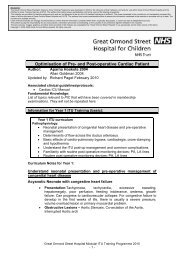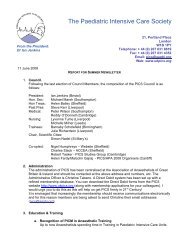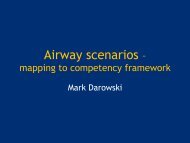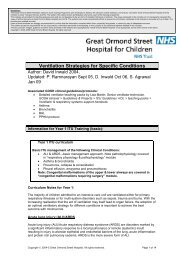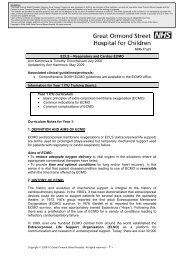Principles of Mechanical Ventilation - PICS
Principles of Mechanical Ventilation - PICS
Principles of Mechanical Ventilation - PICS
Create successful ePaper yourself
Turn your PDF publications into a flip-book with our unique Google optimized e-Paper software.
Disclaimer:The Great Ormond Street Paediatric Intensive Care Training Programme was developed in 2004 by the clinicians <strong>of</strong> that Institution, primarily for use within Great Ormond Street Hospital and theChildren’s Acute Transport Service (CATS). The written information (known as Modules) only forms a part <strong>of</strong> the training programme.The modules are provided for teaching purposes only and are not designed to be any form <strong>of</strong> standard reference or textbook. The views expressed in the modules do not necessarily represent theviews <strong>of</strong> all the clinicians at Great Ormond Street Hospital and CATS. The authors have made considerable efforts to ensure the information contained in the modules is accurate and up to date. Themodules are updated annually.Users <strong>of</strong> these modules are strongly recommended to confirm that the information contained within them, especially drug doses, is correct by way <strong>of</strong> independent sources.The authors accept no responsibility for any inaccuracies, information perceived as misleading, or the success <strong>of</strong> any treatment regimen detailed in the modules.The text, pictures, images, graphics and other items provided in the modules are copyrighted by “Great Ormond Street Hospital” or as appropriate, by the other owners <strong>of</strong> the items.Copyright 2004-2005 Great Ormond Street Hospital. All rights reserved.<strong>Principles</strong> <strong>of</strong> <strong>Ventilation</strong>Joe Brierley, September 2005Updated by Simona Lampariello, May 2007, Shruti Agrawal Dec 08Associated clinical guidelines/protocols: Ventilator user guides on intranet GuidelineFundamental Knowledge:List <strong>of</strong> topics relevant to PIC are covered in membership examinations, will not be repeatedStorage <strong>of</strong> oxygen, NO, Helium, compressed air.Information for Year 1 ITU Training (basic):Year 1 ITU curriculum<strong>Ventilation</strong>: Indications for mechanical ventilation <strong>Principles</strong> <strong>of</strong> ventilation: Flow, volume & pressure relationships Cardiopulmonary interactions in IPPV Basic methods <strong>of</strong> ventilatory support: non-invasive ventilation (face mask IPPV &CPAP) and invasive, positive pressure ventilation using CMV (volume andpressure) and HFOV. Mention assist modes, trigger modes to a basic level. Lung protective ventilation strategies –permissive hypercarbia, low tidal volume,improve V/Q mismatch Detection and management <strong>of</strong> complications <strong>of</strong> mechanical ventilation –volutrauma <strong>Principles</strong> <strong>of</strong> weaning from mechanical ventilationInvestigations: Interpretation <strong>of</strong> blood gas Interpretation <strong>of</strong> chest x-rays; collapse, consolidation, infiltrates (includingALI/ARDS), pneumothorax, pleural effusion, pericardial effusion, position <strong>of</strong>cannulae, tubes or foreign bodies, airway compression, cardiac silhouette,mediastinal massesCurriculum Notes for Year 1:Indications for mechanical ventilation1) Oxygenation abnormalitiesa) Cyanosis with Fi O 2 > 0.6b) PaO 2 < 7 kPa with Fi O 2 > 0.6c) Alveolar-arterial oxygen gradient = P (A-a) O 2 > 450 mm Hg with Fi O 2 1.0d) Shunt fraction > 15-20%e) OthersGreat Ormond Street Hospital Modular ITU Training Programme - 1 -
a. Need for PEEP/Failure to non-invasively oxygenateb. Excessive work <strong>of</strong> breathing with ≈ normal range ventilation2) <strong>Ventilation</strong> abnormalitiesa. Apnoeab. GCS < 8 (also for airway protection)c. Increased airway resistance/obstruction with PaCO 2 and acidosisd. Decreased ventilatory drive with PaCO 2 > or rising PaCO 2e. Neuromuscular diseases e.g. Guillan-BarréFEV
(http://www.draeger.com/MT/internet/pdf/CareAreas/CriticalCare/cc_loops_book_en.pdf)All wonderfully explained in attached basic review article (Pulmonary and renal pressureflowrelationships: what should be taught? Goodman Advan. Physiol Edu 25:15-28,2001;1043-6 AND in ‘Draeger loops booklet’ –attached)Basic methods <strong>of</strong> ventilatory support:1) Non-invasiveAdvantages: Avoids intubation e.g. conditions with high intubation mortality ieimmunodeficiency /oncology, asthma (Ferrer et al. Noninvasive ventilation in severehypoxemic respiratory failure: a randomized clinical trial. Am J Respir Crit Care Med2003;168:1438–44)Avoid re-intubation- (NB Esteban et al. Noninvasive PPV for Respiratory Failure afterExtubation. N Engl J Med 2004; 350:2452-60, 2004)a) ChildrenFace mask/ nasal masks:Sullivan CPAP/IPPV http://resmed.com.au/ data, Evita 4 BiPAP/APRVGreat Ormond Street Hospital Modular ITU Training Programme - 3 -
Helmet ventilation:(Ref: Rocco et al. Noninvasive ventilation by Helmet or facemask in immunocompromisedpatients. Chest 2004; 126: 1508-15.)Advantages: Better tolerated in children phobic to the mask and straps, and also those withdifficulties in fitting the mask.Disadvantages: Misting, difficulty with mouth cares. ? carbon dioxide rebreathing.b) NeonatesEME CPAP, nasal prong/ mask CPAP(Ref: Cochrane Database Syst Rev. 2008; 1: CD00297)HelioxHelium - colourless, odourless, inert gas with no direct pharmacological or biological effects,no intrinsic bronchodilatory or anti-inflammatory properties. Density <strong>of</strong> helium is 1/7 that <strong>of</strong> air.Carbon dioxide diffuses through helium four to five times faster than through air. Heliox is ahelium-oxygen mix. By its lower density, heliox improves gas flow through high-resistanceairways, by changing turbulent flow into a more laminar flow type with improved diffusioncharacteristics.Also, with a lower gas density, helium provides a higher flow rate even if it remains turbulent.Thus, with its lower density, helium as a “carrier gas” results in a lower resistance to gas flowallowing for increased bulk flow, increased oxygen flow, and decreased work <strong>of</strong> breathing.Heliox has shown to prevent intubation in asthma when started early (bridge until steroids kickin) and to improve delivery <strong>of</strong> inhaled bronchodilators. In bronchiolitis, where it has shown toreduce LOS, it may also prevent intubation. In post-extubation stridor it may prevent reintubation.(Ref: Heliox administration in the pediatric intensive care unit: An evidence-based reviewVineet K. Pediatr Crit Care Med 2005;6:204–211, Use <strong>of</strong> Heliox in children. Myers TR. RespCare 2006; 51: 632-9.)2) Invasive• Can manipulate– Minute <strong>Ventilation</strong> - respiratory rate, tidal volume)– Pressure Gradient = A-a equation ( atmospheric pressure, FiO 2 , increaseventilation, change RQ)– Surface Area = volume <strong>of</strong> lungs available for ventilation ( volume by airway pressure, i.e. mean airway pressure)– Solubility = ? perflurocarbons?Ventilators deliver gas to the lungs using positive pressure at a certain rate. Amount <strong>of</strong> gasdelivered can be limited by time, pressure or volume. Duration can be cycled by time,pressure or flow.Great Ormond Street Hospital Modular ITU Training Programme - 4 -
Nomenclature• CPAP: continuous positive pressure ventilation• FiO 2 : fraction <strong>of</strong> inspired oxygen concentration• I;E: inspiratory to expiratory time• MAP: mean airway pressure• PEEP: Positive end expiratory pressure• PIP: Peak inspiratory pressure• RDS: respiratory distress syndrome• T E : expiratory time, T I : inspiratory time• CMV: Conventional mechanical ventilation• Pressure above PEEP (PAP or ΔP)• Tidal Volume: amount <strong>of</strong> gas delivered with each breathModes:• Control Modes:– every breath is fully supported by ventilator– in classic control modes, patients unable to breathe except at the controlledset rate– in newer control modes, machines may act in assist-control, with a minimumset rate and all triggered breaths above that rate also fully supported.• IMV Modes: intermittent mandatory ventilation modes - breaths “above” set rate notsupported• SIMV: vent synchronizes IMV “breath” with patient’s effort• Pressure Support: vent supplies pressure support but no set rate; PS can be fixed orvariable (volume support, volume assured support etc)• Whenever a breath supported by ventilator, regardless <strong>of</strong> mode, the limit <strong>of</strong> supportdetermined by preset pressure OR volume.– Volume Limited: preset tidal volume– Pressure Limited: preset PIP or PAPIf volume is set, pressure varies, if pressure is set, volume varies, according to compliance.Great Ormond Street Hospital Modular ITU Training Programme - 5 -
COMPLIANCE = Volume / Pressure(Ref: Burton SL & Hubmayr RD: Determinants <strong>of</strong> Patient-ventilator Interactions: BedsideWaveform Analysis, in Tobin MJ (ed): <strong>Principles</strong> & Practice <strong>of</strong> Intensive Care Monitoring)High Frequency Oscillation (HFOV)(Courtesy: sensormedics website)Provides small tidal volumes (really an Amplitude referred to as Delta P) usually equal to, orless than, the dead space; 150 millilitres, at very fast rate (Hertz-Hz) <strong>of</strong> between 4-5 breathsper second. Enables maintenance <strong>of</strong> minute volume. Lungs kept open to constant airwaypressure via mean pressure adjust system (ideal ‘lung-protective ventilation’). Further, HFOVallows for the decoupling <strong>of</strong> oxygenation from ventilation allows separate adjustment <strong>of</strong> eitheroxygenation or ventilation.Core is a piston assembly incorporating an electronic control circuit, or square-wave driverpowering a linear drive motor consisting <strong>of</strong> an electrical coil within a magnet (cf permanentmagnet speaker). When positive polarity applied to square-wave driver coil is driven forward.Coil attached to rubber bellows (or diaphragm) to create piston. When coil moves forwardpiston moves toward patient airway creating inspiratory phase and vice versaAmplitude -means by which TVs delivered (greater amplitude-more volume). Pistondisplacement → oscillations. Extent amplitude increases depends on resistence topiston eg low compliance- greater pressure in inspiratory phase.Since tidal volumes so low, gas transport mechanisms other than conventional bulkflow must be invoked to explain gas and CO2 flow (see gas transport….)Mean Pressure Adjust (Paw). Mushroom shaped control valve on end <strong>of</strong> expiratorylimb-allows manipulation <strong>of</strong> Paw enables lung recruitment, keeps lungs and alveoliopen at consent pressure avoiding lung expansion/collapse.Oscillator speed set by manipulating frequency. Breaths/min in Hertz (Hz). 1 Hzequal to one breath/sec i.e.60 breaths/min. 5 Hz gives 5 breaths/sec= 300 breaths/min. NB as frequency increased piston excursion ltd by time allocated each breathGreat Ormond Street Hospital Modular ITU Training Programme - 6 -
Gas transport under non-physiologic conditionso Bulk flow can still provide conventional gas delivery to proximal alveoli with low regionaldead space volumeso Coaxial flow. Gas in the centre flows inward, gas on the periphery flows outward. Candevelop because <strong>of</strong> the asymmetric low pr<strong>of</strong>ile <strong>of</strong> high velocity gaseso Taylor dispersion produces mixing fresh + residual gas along front <strong>of</strong> flow <strong>of</strong> gas throughtube.o Pendelluft can mix gases between lung regions having different impedances.o Augmented molecular diffusion can occur at alveolar level secondary to added kineticenergy from oscillationsRef:1. Siau C, Stewart TE. Current role <strong>of</strong> high frequency oscillatory ventilation and airwaypressure release ventilation in acute lung injury and ARDS. Clin Chest Med 2008; 29: 265-75.2. High-frequency ventilation in the pediatric intensive care unit. John H. Arnold, MD. PediatrCrit Care Med 2000 Vol. 1, No. 2Dani et al (Effects <strong>of</strong> pressure support ventilation plus volume guarantee vs high-frequencyoscillatory ventilation on lung inflammation in preterm infants. Pediatr Pulmonol 2006; 41:242-9) recently demonstrated a reduction in lung inflammation in premature neonates randomizedto HFOV when compared with patients treated with pressure support ventilation with volumeguarantee. Jaballah et al.(High-frequency oscillatory ventilation in pediatric patients withacute respiratory failure. Pediatr Crit Care Med 2006; 7:362–7) also recently reportedsuccessful use <strong>of</strong> HFOV as a rescue technique in paediatric patients who had failed CMV.Mehta et al. (High-frequency oscillatory ventilation in adults: the Toronto experience. Chest2004; 126:518-27) reported successful use <strong>of</strong> HFOV as a rescue mode for adults with severeoxygenation failure treated with CMV. Authors also suggested that earlier implementation <strong>of</strong>HFOV may be beneficial, as number <strong>of</strong> days <strong>of</strong> CMV prior to initiation <strong>of</strong> HFOV was found tobe an independent predictor <strong>of</strong> mortality.Lung protective ventilation strategies(For reasoning see under complications <strong>of</strong> ventilation)1) lower tidal volume and higher PEEP (Amato MB et al. Effect <strong>of</strong> protective-ventilationstrategy on mortality in ARDS. N Engl J Med. 1998 Feb 5;338(6):347-54. AND Lower TV-ARDS network) prevent ventilator-induced lung injury, and optimize oxygen delivery. Oldgoal <strong>of</strong> maintaining PaCO 2 in normal range at all costs replaced with realization that largeswings in VT → severe lung injury (volutrauma or barotrauma) and ↑ pro-inflammatorycytokines.2) Improve V/Q mismatchProne PositioningEffect <strong>of</strong> Prone Positioning on the Survival <strong>of</strong> Patients with Acute Respiratory Failure.Gattinoni L et al. New Engl J Med 2001; 345:568-573Different areas <strong>of</strong> alveolar collapse in dependent lung regions ARDS patients. No pronepositioning reports perfect. Addition <strong>of</strong> treatment that improves oxygenation as bodyattempts to heal itself just makes sense. Hard to show mortality change from 1 therapy alone.Great Ormond Street Hospital Modular ITU Training Programme - 7 -
Care c pressure areas, makes access difficult. Data supports prone positioning in selectedchildren with ARDS.Effect <strong>of</strong> mechanical ventilation in the prone position on clinical outcomes in patients withacute hypoxemic respiratory failure: a systematic review and meta-analysis. Sud et al, CMAJ.2008 Apr 22; 78: 1153-61. Review.A Randomized Trial <strong>of</strong> Prolonged Prone Positioning in Children With Acute RespiratoryFailure. Kornecki A et al. Chest 2001 119: 211-2182) Permissive hypercarbia- (Hickling K et al. Low mortality associated with low volumepressure ltd ventilation with permissive hypercapnia in severe ARDS. Intensive Care Med1990;16:372-377. Hypercapnia: permissive and therapeutic. Kavanagh et al, MinervaAnestesiol. 2006 Jun; 72: 567-76) consequence <strong>of</strong> ventilation strategy accepting deliberatehypoventilation in order to reduce lung overdistension increase transalveolar pressures withincompliant, non-collapsed lung. Potential problem is increased patient respiratory drive,therefore increased need for sedation.a)Aim arterial pH >7.25 ignore pCO 2b) Alkalising maybe step too farN.B. Avoid in patients with raised ICP.Detection and management <strong>of</strong> complications <strong>of</strong>mechanical ventilation – volutraumaEvolving concept in ALI and ARDS - iatrogenic lung injury secondary to high tidal volumes(TV) which can lead to overdistension <strong>of</strong> alveoli. ARDS is a heterogeneous disease withcollapse, non-recruited lung adjacent to normal lung. Large TV 10-15 ml/kg, unevenlydistributed overdistension <strong>of</strong> compliant alveoli local hyperventilation and surfactantinhibition+depletion. Repetitive opening and closing <strong>of</strong> recruitable alveoli → shearing injurythought to contribute to process.Injury is due to excess volume but reflected clinically by static or plateau airway pressures.Animal studies suggest transalveolar pressure > 30 mm Hg contributes to significant injury.Correlates to static or plateau airway pressure <strong>of</strong> 30-40 cm H2O, depending on chest wallcompliance→concept <strong>of</strong> pressure-targeted ventilation which emphasizes lower TV (4-8 ml/kg)in effort to keep static airway pressures in lower range<strong>Principles</strong> <strong>of</strong> weaning from ventilationhttp://pedsccm.wustl.edu/ebjournal_club.html -evidence based weaning reviewsFormal assessment ventilation discontinued if following criteria satisfied:1. Evidence for some reversal <strong>of</strong> underlying cause for respiratory failure;2. Adequate oxygenation (eg PaO 2 /FiO 2 ratio > 150 to 200; PEEP 5 to 8 cm H 2 O; FiO 20.4 to 0.5); and pH (eg 7.25);3. Haemodynamic stability4. The capability to initiate an inspiratory effort.Great Ormond Street Hospital Modular ITU Training Programme - 8 -
CriteriaDescriptionObjective measurementsAdequate oxygenation (eg, PO 2 60 mmHg on FIO 2 0.4; PEEP 5–10cm H 2 O; PO 2 /FIO 2 150–300);Stable CVS (eg, HR 140; stable BP; no (or minimal) pressors)Afebrile (temperature < 38°C)No significant respiratory acidosisAdequate hemoglobin (eg, Hgb 8–10 g/dL)Subjective clinicalassessmentsAdequate mentation (eg, arousable, GCSStable metabolic status (eg, acceptable electrolytes)13, no sedative infusions)Resolution <strong>of</strong> disease acute phase; physician believes discontinuationpossible; adequate coughHgb = haemoglobin; HR = heart rate; GCS = Glasgow coma scale.Failure to Wean GuidelinesLOADDRIVECAPACITY OFRESPIRATORY PUMPBronchospasm Sedation Treat pain and discomfortLeft ventricular failure CNS diseaseTreat abdominal discomfortSepsisHypercarbia Optimize position Fever Self-esteemLook for diaphragmaticparalysisSeizure ControlOther causes <strong>of</strong> increasedBasal metabolic rateIs there evidence <strong>of</strong>: Consider Optimize strengthExcessive secretions Hb Muscle weaknessHyperinflation Anxiety NeuropathyHave muscle relaxants worn<strong>of</strong>f?FearDisuse atrophySensory overload/deprivation NutritionPleural effusion/pneumothoraxRest/sleepElectrolytesInterpretation <strong>of</strong> blood gasa) PaO 2 , SaO 2 and O 2 Content -Martin All You Really Need to Know toInterpret ABGs 1999 Lippincott Williams & Wilkinsb) PPT from peds ccm ‘02_blood_gas’ in ICUc) NB Stewart’s strong ion theory alternative to Henderson-Hasselbach forthose <strong>of</strong> you ever working South <strong>of</strong> river/on with Sophie S (author 3 onpaper!) The strong ion gap predicts mortality in children followingcardiopulmonary bypass surgery. Durward et al. Pediatr Crit Care Med2005 Vol. 6, No. 3Great Ormond Street Hospital Modular ITU Training Programme - 9 -
Interpretation <strong>of</strong> CXRs;Most <strong>of</strong> these you should already know but Virtual hospital explains them athttp://www.radquiz.com/Thoracic-Imaging.htmShould we do daily CXR? Quasney et al Routine Chest Radiographs in PICU.PEDIATRICS Vol. 107 No 2 Feb 2001Other sources <strong>of</strong> information:Websites. http://medocs.ucdavis.edu/IMD/420C/esyllabus/ventilat.htm good intro herehttp://pedsccm.wustl.edu/EBJournal_club.html evidence based papersReferences. See textGreat Ormond Street Hospital Modular ITU Training Programme - 10 -
Pressure regulatorsGas and vapour stored under high pressure in cylindersRegulator reduces variable cylinder pressure to constant working pressure -around 400kPa -just under pipeline pressureTemperature and pressure <strong>of</strong> cylinder decrease with use, regulator avoids need forconstant adjustment to maintain flowRegulatorInlet leading to high pressure chamber with valveValve leads to low pressure chamber and outletDiaphragm attached to spring situated in low pressure chamberMechanismBalance between inlet pressure and springed diaphragm keeps gas flow at 400kPaCaveatsDiaphragm can ruptureFlow control valve (needle valves) and flow meterFlow control valveManually adjustedScrew into base <strong>of</strong> flow meterIncrease gas flow by turning screw anti-clockwiseFlow meterCalibrated for gas used at room temp and atmospheric pressure -Accurate+- 2.5%Gravity <strong>of</strong> bobbin v gas pressure below-constant pressure difference as floatsMeasure from top <strong>of</strong> bobbin, or middle <strong>of</strong> ballBobbin slits make it rotate so know is movingLow flow meters (NICU) for flow < 1 l/minVaporizerChanges liquid inhalational agent to vapour, adds controlled amount to fresh gas flowExpressed % <strong>of</strong> saturated vapour addedVapour is gaseous state <strong>of</strong> substance below critical temperature. At room temp andatmospheric pressure substance is liquid. Critical temp is when substance cannot beliquefied no matter how much pressure applied (-118 °C for O2)Colour codedRed-halothane Purple-enflurane Purple-is<strong>of</strong>luraneYellow-sev<strong>of</strong>lurane Blue – desfluraneGreat Ormond Street Hospital Modular ITU Training Programme - 12 -
Breathing systems- http://www.nda.ox.ac.uk/wfsa/html/u07/u07_013.htm#moddComponentsReservoir-2 l adults, 0.5 smallest paediatirc sizeTubing-corrugated plastic (rubber in anaesthetics)Various configurations-see Mapleson systemAdjusted pressure relief valve-with 1l bag ICUMapleson system ABCDEF added (REF)ICU-most commonly used A and F = T-piece system500 ml bag-open ended (F) for CPAP, scavenging a problem1 l bag, PEEP via APL –no need scavenge for O2/airDisconnect monitorsPressure monitors in circuitEnd-tidal CO2Saturation probe- too late!!Scavenging systems for waste gases (? NO important)Collects waste gases from ventilator and discards safelyCollection, transfer, receival and disposal systemsPassive vs activePassiveShroud connected to expiratory valve <strong>of</strong> ventilator and transfer tubing? Receiving system (eg reservoir bag)Disposal system –to atmosphere or ventilation systemActiveSame collection and transfer as aboveDisposal system is active with fan or pump creating vacuumCan deal with wider ranges <strong>of</strong> flowOthers<strong>Ventilation</strong> <strong>of</strong> unitUse <strong>of</strong> inhalational agents rare on ICU, ? NO importantTheatreLocal/regional anaesthesiaCircle systemCardiff Aldasorber (charcoal based passive system)Pipeline and suction systemsSuction system-airway management/chest drains etcPortable suction-transfers (in-hospital/intra-hospital)Centalized vacuum systemPump, reliever and filterPumpcreates negative pressure <strong>of</strong> 400mmHgAccommodates air flow <strong>of</strong> 40 l/minRecommended 1 outlet per bedHumidificationDry gas damages respiratory epithelial cells Susceptibility to LRTITemperature instability-loss <strong>of</strong> latent heat <strong>of</strong> vaporisationa) Heat and moisture exchange humidifiers (HME) (CATS/transfer)Small, cheap, effective and no need for external power sourceInspired gases warmed to 30-34°CRelative humidity 60-70% ie adequateAdds condensation and heat <strong>of</strong> patients exhaled gas to next inspired breathHMEF include anti-bacterial filterIncreases dead spaceAffected by tidal volume, gas temperature, flow rate etcGreat Ormond Street Hospital Modular ITU Training Programme - 13 -
) Hot water bath humidifier (More usual on ICU)More effective than HMEGas inlet/outlet thermostat Tubing and water trap (put lower than pt)Large surface area so most gas fully saturated and heated 37°CThermistor near ETT allows feedback loopBacterial colonization/risk <strong>of</strong> scaldingNeeds electrical power cf HMEMore advanced methods <strong>of</strong> ventilatory support: non-invasiveventilation (-ve pressure jacket) and invasive, positive pressureventilation using CMV, assist modes, trigger modes, HFOV.Advantages and disadvantages <strong>of</strong> each mode.Hayek Negative pressure CPAP/oscillate -better cardiopulmonary interaction.Constant negative pressure throughout the respiratory cycle increases functional residualcapacity (FRC) and is equivalent to a positive end expiratory pressure produced inside theairway.NPV causes inhibition <strong>of</strong> respiratory muscle activity, decreasing in both diaphragmaticelectrical activity and mechanical activity <strong>of</strong> the diaphragm, with significant decrease in thework <strong>of</strong> breathing.We have also used in attempt to not intubate eg muscular problems, and also occasionallywith intubated patient synchrosed to aid cardiac output. In patients with the Fontan circulationthe absence <strong>of</strong> a right ventricle, means that pulmonary blood flow, the major determinant <strong>of</strong>cardiac output, is a passive diastolic phenomenon, enhanced as the pleural pressurebecomes negative during spontaneous inspiration, but reduced or even zero when theintrathoracic pressure is made more positive. By mimicking spontaneous respiration, negativepressure ventilation augments the cardiac output <strong>of</strong> Fontan patients to levels that areunrivalled by other forms <strong>of</strong> treatment.Disadvantages: as good seal is necessary around the patient, it is important to protect theskin at contact points and avoid venous obstruction. Occasionally observed is extrathoracicupper airway obstruction due to suppression <strong>of</strong> the normal pre-inspiratory activation <strong>of</strong> upperairway muscles, rendering upper airway structures floppier and more susceptible to passiveclosure. Can be overcome by nCPAP/fm IPPV.ModesSuppression <strong>of</strong> spontaneous breathing and complete dependence on mechanical ventilation→ respiratory muscle atrophy –so modes allowing spontaneous breathing or patient-triggeredmodes favoured when feasibleAssist/Control Mode <strong>Ventilation</strong>Combined mode <strong>of</strong> ventilation. Ventilator delivers positive pressure breath <strong>of</strong> predeterminedTV in response to each inspiratory effort (assisted ventilation).If pt fails to initiate breath within a specific time period, ventilator automatically delivers amechanical breath to maintain minimum or “backup” respiratory rate (controlled ventilation).To trigger assisted breath must lower airway pressure by preset amount- the triggersensitivity.Great Ormond Street Hospital Modular ITU Training Programme - 14 -
Advantages:1. Pt able to perform variable amount <strong>of</strong> respiratory work with security <strong>of</strong> presetmandatory level <strong>of</strong> ventilation;2. Allows for variation in support-full support to spontaneous breathing3. Useful weaning mode.Disadvantages:1. Dysynchrony between pt effort and machine-delivered volume can occur especiallywith inadequate flow rates;2. Hyperventilation and respiratory alkalosis possible, similar to A/C;3. Excessive work <strong>of</strong> breathing during spontaneous breaths can occur due to presence<strong>of</strong> poorly responsive demand valve or inappropriate flow delivery;4. May potentially worsen air trapping with asthma.Pressure-Support <strong>Ventilation</strong>With each spontaneous breath the negative pressure or flow in inspiratory circuit opens valve→ ventilator delivers flow <strong>of</strong> gas sufficient to maintain a constant inflation pressure. Wheninspiratory flow rate falls below preset threshold, flow <strong>of</strong> gas terminates. Patient controlsrespiratory rate and inspiratory time and flow. TV + minute ventilation partly determined bypatient + partly by ventilator. TV received depends on set level <strong>of</strong> pressure support, patienteffort, and the pulmonary mechanics. Pressure support may also be applied to a patient’sspontaneous breathing during SIMVAdvantages:1. Most spontaneously breathing pts comfortable with little dys-synchrony.Great Ormond Street Hospital Modular ITU Training Programme - 16 -
2. Work <strong>of</strong> breathing in proportion to delivered pressure and associated with respiratory frequency and TV with levels <strong>of</strong> PS.3. PS can be used to compensate for extra work produced by ETT and demand valve.4. Allows wide variation in level <strong>of</strong> partial ventilatory support from nearly total support(high pressure levels) to essentially spontaneous breathing. Hence useful as weaningtool.Disadvantages:1. Tidal volume dependent on respiratory mechanics, cycling frequency, and patientventilatorsynchrony. Hence need careful monitoring for unstable patients and backupminute ventilation needed for safety.2. Pressure support ventilation may be poorly tolerated in some patients with highairway resistance because <strong>of</strong> the preset high initial flow and terminal inspiratory flowalgorithms. This may be improved, however, with adjustment <strong>of</strong> initial flow rates.OthersPressure Control <strong>Ventilation</strong> (PCV)PCV more popular as recent attention focused on minimizing static airway pressures in ARDSpatients. PCV involves setting target airway pressure on ventilator which then delivers rapidflow to that set pressure with a square pressure wave form. TV depends upon complianceand can vary as condition improves or deteriorates. Flow curve for pressure control isdecelerating curve ? some advantages over volume-cycled ventilation in maintaining recruitedalveoli and thus improving oxygenation.Advantages:1. Airway pressures uniformly controlled by set pressure limit thus minimizingoverdistension2. Decelerating flow curve ? allows improved oxygenation by optimizing alveolarrecruitmentDisadvantages:1. Can be an uncomfortable mode <strong>of</strong> ventilation and thus require significant sedation2. TV varies with compliance → close monitoring avoid excessive/inadequate ventilationPressure regulated volume control (PRVC)Good alternative to PCV if rapidly changing compliance -Remains a pressure regulatedapproach but pressure varies to maintain given tidal volume. Uses decelerating flow curve <strong>of</strong>pressure control so maintains this advantage while avoiding complications <strong>of</strong> excessive orinadequate ventilation as lung compliance changesAirway Pressure Release <strong>Ventilation</strong> (APRV)Spontaneous breathing with CPAP interrupted by short (1-1.5s) releases <strong>of</strong> pressure toaugment expiration. Moderately high airway pressure (20-30 cm H 2 O) most <strong>of</strong> the time,thereby keeping alveoli open. Unique in that ventilation is enhanced by reduction rather thanincrease in lung volume. During short expiratory release PEEP remains present to keepalveoli with slow time constants open as well (Schultz TR, Costarino AJA, Durning SM, et al.Airway pressure release ventilation in pediatrics. Pediatr Crit Care Med 2001; 2:243–246).Great Ormond Street Hospital Modular ITU Training Programme - 17 -
Disadvantages: inadvertent PEEP Necrotizing Tracheo-bronchitis (NTB) Expose hypovolaemia/impaired cardiac function Patient ventilator interactionLoads <strong>of</strong> papers on use:-www.sccm.org/specialties/pediatric/picu_course/Documents/catalog_pdf/03_high_frequency_oscillatory_vent.pdfArnold JH, Hanson JH, Toro-Figuero LO, Gutierrez J, Berens RJ, Anglin DL.Prospective, randomized comparison <strong>of</strong> high-frequency oscillatory ventilation andconventional mechanical ventilation in pediatric respiratory failure. Crit Care Med.1994;22(10):1530-9Derdak S, Mehta S, Stewart TE et al. High-Frequency Oscillatory <strong>Ventilation</strong> forAcute Respiratory Distress Syndrome in Adults. Am J Resp Crit Care Med 2002;166:801-808Lung protective ventilation strategies –1-3 see year 14) Recruitment -(Rimensberger P et al. Lung recruitment and lung volume maintenance:strategy for improving oxygenation and preventing lung injury during both conventionalmechanical ventilation and high-frequency oscillation. Intensive Care Med. 2000Jun;26(6):745-55)http://www.medscape.com/viewarticle/427184 How the Experts Ventilate Patients With ARDSConcept <strong>of</strong> re-inflating atelectatic aveoli, maintaining above FRC to prevent cyclical collapseReview <strong>of</strong> ARDS adult recruitment (Lung Recruitment + Setting <strong>of</strong> PEEPwww.imhotep.net/kacmarekr.html5 )Inversed ratio ventilation (IRV)-see above under modes6)Improving VQ matching-see year 17) OthersSurfactant - Willson DF (Effect <strong>of</strong> exogenous surfactant (calfactant) in pediatric acutelung injury: a randomized controlled trial., JAMA. 2005 Jan 26;293(4):470-6) showed areduction in mortality with two doses <strong>of</strong> calfactant in the first 24 hrs, however multivariateanalysis, revealed that this mortality difference was not statistically significant onceadjustments were made for the immune status <strong>of</strong> the patients.INO – reverses V˙ /Q˙ mismatch seen in ARDS by selectively mediating pulmonaryvasomotor tone in well ventilated lung units and subsequently reducing increased pulmonaryvascular resistance and pulmonary hypertension. A meta-analysis (Inhaled Nitric Oxide forAcute Hypoxic Respiratory Failure in Children and Adults: A meta-analysis, Jennifer Sokol,Anesth Analg 2003;97:989 –98) suggests that INO transiently results in improved oxygenationin ARF, with no discrepancy between small or large doses, but that is has not demonstrated asignificant effect on mortality. However most trials are poorly conducted.Detection and management <strong>of</strong> complications <strong>of</strong> mechanical ventilation –volutrauma, oxygen toxicity, inflammation.Significant complications associated with mechanical ventilation complications include:oxygen toxicity, alveolar stretch injury or volutrauma, barotrauma, patient-ventilatorasynchrony, nosocomial pneumonia, and adverse effects on cardiac function and output.Great Ormond Street Hospital Modular ITU Training Programme - 19 -
1. Oxygen Toxicity:Recognized for years that high FiO 2 commonly used during mechanical ventilation can causeiatrogenic lung injury. Pathophysiology underlying these changes can be divided into 2categories: alteration <strong>of</strong> normal physiology and oxygen-induced tissue injury.a) Alterations in normal pulmonary physiologyinclude: depression <strong>of</strong> ventilation, vasodilation <strong>of</strong> pulmonary vasculature, ↓ production <strong>of</strong>surfactant, and absorption atelectasis- (from wash out <strong>of</strong> the normal concentration <strong>of</strong> alveolarnitrogen which acts as a splint to keep alveoli open during expiration). Effect most prominentin severe parenchymal lung disease can exacerbate intrapulmonary shunting.b) Toxic reactive O 2 species which cause free radical damage to lung tissue.→ disruption <strong>of</strong> pulmonary capillary endothelial cells and alveolar epithelial cells which alterspermeability → interstitial oedema. Degree <strong>of</strong> injury depends upon a number <strong>of</strong> factorsincluding FiO 2 and duration <strong>of</strong> exposure. Normal lungs may tolerate FiO 2 up to 0.60 whereasinjured lung may be damaged at concentration greater than 0.50.Estimated oxygen toxicity clinically significant when exposure > 8 -12 hours → trend towardlower FiO 2 in conjunction with increased use <strong>of</strong> PEEP to maintain oxygenation has developed2. Volutrauma / Stretch Injury:See year 13. Barotrauma:Includes development <strong>of</strong> pneumothorax, pneumomediastinum, pneumopericardium, air cysts,pulmonary interstitial emphysema, intraparenchymal tension cavities, and systemic gasembolism.Barotrauma most common with severe parenchymal injury ie ARDS. Ongoing debateconcerning relationship high ventilatory pressures and barotrauma as recent studies unable todefine a clear relationship between elevated PIPs and pneumothorax.More relevant may be transpulmonary pressure which is alveolar pressure minus the pleuralpressure -supported by observation very high airway pressures <strong>of</strong>ten reached withoutbarotrauma. Important, however, to maintain a high index <strong>of</strong> suspicion for development <strong>of</strong>barotrauma, as tension pneumothorax can be a life-threatening4. Patient-Ventilator Asynchrony:Occurs primarily in patients receiving partial ventilatory support. Inappropriate triggering, flowdelivery, and cycling criteria on the ventilator can cause significant imposed load anddiscomfort resulting in need for substantial sedation. Particularly important when usingalternative modes <strong>of</strong> ventilation which can be extremely uncomfortable eg PCV and IRV5. Nosocomial Pneumonia:Prolonged endotracheal intubation leads to alteration in normal endo-bronchial flora →increased susceptibility to lower tract infection. Nosocomial pneumonia is one <strong>of</strong> the mostserious complications that can occur with mechanical ventilation and significantly delaysweaning and lengthens ICU stay6. Effects On Cardiac Function:See cardiopulmonary interaction with PPVGreat Ormond Street Hospital Modular ITU Training Programme - 20 -
Long-term or home ventilationUsually under respiratory team - TCU/resp ward :-Temporary eg malacia, CLD (months) diaphragmatic paralysis-(? years)Permanent eg high spinal cord lesion-Intermittent eg nocturnal face mask BiPAP-continuous -tracheostomy and Sullivan/BreezePartial liquid ventilationVentilating with conventional ventilation after filling with perfluorocarbonEg perflubron20 times heavier than O2 + heavier than waterhigher spreading co-efficientanimal models suggest improved compliance and gas exchangePoor results so on hold at GOSH? Some new lung growth Glasgow in ECMO for CDHIndications for, risks <strong>of</strong> and limitations <strong>of</strong>: spiral /chest CT, VQ scan,bronchograms+broncoscopySpiral /chest CTIndication-failure to wean etc; Risk- transport to CT, radiation vs diagnosis/Limitation-need for transfer-<strong>of</strong>ten on HFOV/prone etcEg missed PTX(Thomas et al .Efficacy chest CT in PICU. Chest.2000;117:1697)<strong>Ventilation</strong>/perfusion scanIndications-R/O PE, delineate congenital lung disease pre-op, investigate diffuse lungdisease /Risk-trip to VQ/limitations-technical?PEGreat Ormond Street Hospital Modular ITU Training Programme - 21 -
V/Q scan -air trapping and decreased perfusion lower 2/3 Rt lung= Congenital LobarEmphysema, Right Middle Lobe(http://erj.ersjournals.com/content/vol18/issue3/images/large/erj180589-1.jpeg)BronchogramsIndication-investigation tracheobronchial malacia or stenosis, routine investigation pretrachealsurgery at GOS-assess dynamic feature <strong>of</strong> obstruction Inwald D et al. Current Mx + outcome TBM + stenosis presenting PICU. INTENSIVECARE MED.27/4(2001)722-9 Elliott et al. Mx congenital tracheal stenosis. Int’ Congress Series 1254 (2003) 321–33Bronchoscopy in PICU.Andy Bush et none. Bronchoscopy in paediatric intensive care. Paediatric RespiratoryReviews. Volume 4, Issue 1 , March 2003, Pages 67-73)Indications -endobronchial toilet, instilling recombinant human DNAase (even non-CFchildren) checking tube patency and position; assisting difficult intubation or tube change;selective intubation <strong>of</strong> a main bronchus; diagnosis and management <strong>of</strong> ventilator-associatedpneumonia or the ventilated, immunocompromised host; the assessment <strong>of</strong> lobar collapse orfocal hyperinflation; airway stent assessment; assessment <strong>of</strong> stridor on extubation and thediagnosis <strong>of</strong> any associated diseaseRespiratory function tests: simple tests <strong>of</strong> pulmonary function e.g.PEFR, spirometry, pneumotachograph and other respirometersRespiratory monitoring tools in the intensive care unit attachedNon-invasive respiratory monitoring in paediatric intensive care unit attachedBasic forms should be familiar from base specialityOutcome prediction.1) Dahlem et al. Incidence and short-term outcome <strong>of</strong> acute lung injury in mechanicallyventilated children. Eur Respir J. 2003 Dec;22(6):980-5.2) Marcin et al.Certainty and mortality prediction in critically ill children. J Med Ethics2004;30:304–307. doi: 10.1136/jme.2003.001537Other sources <strong>of</strong> information: http://pedsccm.wustl.edu/FILE-INET/File_cab_index.htmls <strong>of</strong> stuffGreat Ormond Street Hospital Modular ITU Training Programme - 22 -



